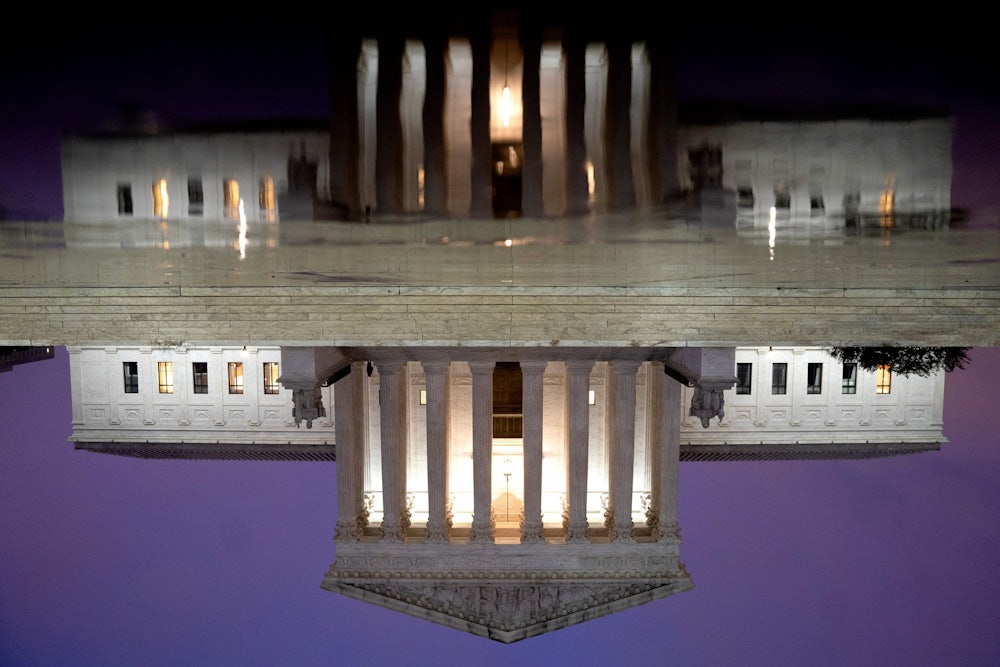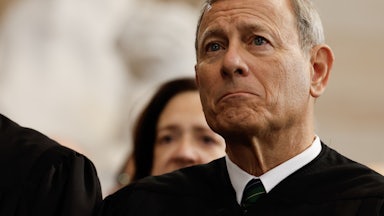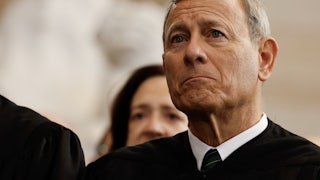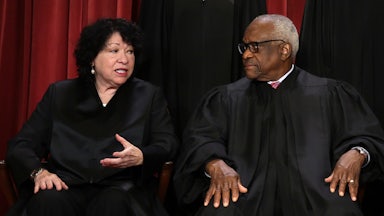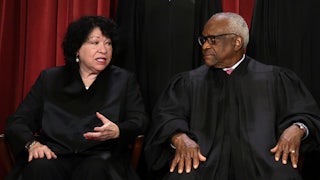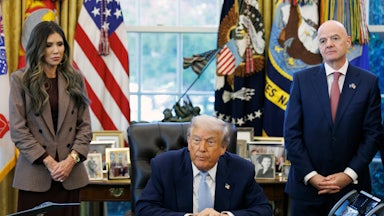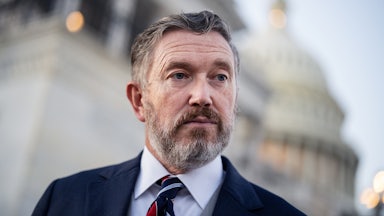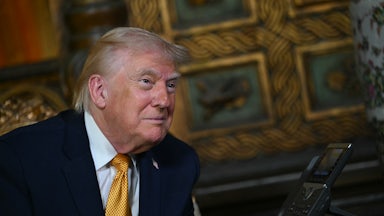To cover the Supreme Court these days is to catalogue its lawlessness. The conservative justices’ latest decision in McMahon v. New York allows the president to effectively demolish the Department of Education—a Cabinet-level department that was created by Congress, given duties and responsibilities by Congress, and funded by Congress to carry them out.
Secretary of Education Linda McMahon, a pro-wrestling promoter and sexual-abuse lawsuit defendant, made no secret of her goals after taking up her current job. In a speech in March, she declared that the department was to carry out its “final mission”: executing a mandate from President Donald Trump to shutter the department and transfer some of its functions to other agencies. Project 2025, the administration’s de facto policy blueprint, also said the department “should be eliminated.”
A week after taking up her post, McMahon put that plan into action by ordering a “reduction in force,” or RIF, of roughly half of the agency’s employees. The state of New York and other plaintiffs sued McMahon to stop the RIF by arguing that it was a back-door means to end the department’s statutory responsibilities by eliminating the staff responsible for carrying them out.
This was not particularly difficult for the plaintiffs to prove: Trump administration officials publicly described the RIF as part of the “final mission” in alignment with an executive order that directed McMahon to “take all necessary steps to facilitate the closure of the Department of Education” while also “ensuring the effective and uninterrupted delivery of services, programs, and benefits on which Americans rely”—two obviously contradictory goals.
Unsurprisingly, a federal district-court judge granted the plaintiffs a temporary restraining order shortly thereafter. The lower court concluded from the record that the RIF’s actual goal was to “effectively dismantle the Department without an authorizing statute.” When the Trump administration appealed that restraining order to the Supreme Court, it pled ignorance. The district court, the Trump Justice Department argued, “[lacked] jurisdiction to second-guess the executive [branch]’s internal management decisions” and that the order was about “streamlining” the department.
“The government has been crystal clear in acknowledging that only Congress can eliminate the Department of Education,” Solicitor General D. John Sauer told the justices in his filing. “And the government has acknowledged the need to retain sufficient staff to continue fulfilling statutorily mandated functions and has kept the personnel that, in its judgment, are necessary for those tasks. The challenged RIF is fully consistent with that approach.”
The Supreme Court’s conservative majority was gullible enough to believe that. As with almost any other shadow-docket ruling, the court did not bother to explain itself. It fell to Justice Sonia Sotomayor, writing in dissent alongside Justices Elena Kagan and Ketanji Brown Jackson, to explain the gravity of the court’s error. For one thing, Sotomayor noted that black-letter federal law prohibits the Trump administration from doing exactly what it says it is doing.
Congress has prohibited the Secretary of Education from “aboli[shing] organizational entities established” in the Department’s organic statute. 20 U. S. C. §3473(a)(2). As for statutory entities “transferred to the Department,” the Secretary may only “consolidate, alter, or discontinue” a subset of entities specifically identified, after providing Congress with 90 days’ advance notice and a “statement of the action proposed . . . and the facts and circumstances relied upon in support of such proposed action.”
She also emphasized the damage that would result from the court’s decision. “Lifting the district court’s injunction will unleash untold harm, delaying or denying educational opportunities and leaving students to suffer from discrimination, sexual assault, and other civil rights violations without the federal resources Congress intended,” she explained. “The majority apparently deems it more important to free the Government from paying employees it had no right to fire than to avert these very real harms while the litigation continues.”
Compare this approach to the one the court took two years ago in Biden v. Nebraska. The Biden administration had invoked the HEROES Act of 2003, which allows the secretary of education to “waive or modify any statutory or regulatory provision” in relation to federal student-loan programs during a national emergency, to forgive roughly $400 billion in student loans to millions of debtors. It was an expansive reading of the statute, to be sure, but not an absurd or clearly erroneous one.
After struggling for weeks to find a remotely plausible theory of standing, a group of Republican-led states sued the Biden administration under the premise that it injured MOHELA, a legally independent student-loan servicer created by the Missouri legislature. They asked the courts to block the secretary of education’s order and attained a nationwide injunction to prevent it from going into effect, which the Supreme Court did not deign to disturb. (The conservative majority’s eventual distaste for nationwide injunctions would not manifest until the moment a Republican retook the White House.)
The conservative justices could barely disguise their hostility towards the policy. Justice Neil Gorsuch asked then-Solicitor General Elizabeth Prelogar, who argued on behalf of the Biden administration, if the administration had considered the costs of its order to “other persons in terms of fairness, for example, people who have paid their loans, people who have planned their lives around not seeking loans, and people who are not eligible for loans in the first place—and that a half a trillion dollars is being diverted to one group of favored persons over others.”
Roberts even went on an extended monologue about a hypothetical involving two guys who went to the same high school—one who got a student loan to attend college, and one who got a bank loan to start a lawn-care business. “And then along comes the government and tells that person: You don’t have to pay your loan,” he complained. “Nobody’s telling the person who is trying to set up the lawn service business that he doesn’t have to pay his loan. He still does, even though his tax dollars are going to support the forgiveness of the loan for the college graduate, who’s now going to make a lot more than him over the course of his lifetime.”
“I may have views on the fairness of that and mine don’t count,” Roberts continued. “We like to usually leave situations of that sort, when you’re talking about spending the government’s money, which is the taxpayers’ money, to the people in charge of the money, which is Congress.” He then asked if that should be part of the court’s consideration when it evaluated the Biden order under the “major-questions doctrine,” a Roberts Court invention that gives the justices a freewheeling veto over policy decisions if the court thinks Congress didn’t “speak clearly enough” in an authorizing statute. This “doctrine” has yet to be used against a Republican president.
Nevertheless, the answer to Roberts’ question was, apparently, “yes.” The Supreme Court struck down the order by invoking the major-questions doctrine and brushed aside the dubious standing grounds. (MOHELA, which can bring lawsuits on its own accord, pointedly declined to do so here.) Paradoxically, the Biden administration received the most blame for the defeat during the next election, even though it was the court that ultimately blocked the biggest push for student-debt forgiveness.
To sum up: In Robertsworld, a Democratic president can’t use a federal law that lets the Department of Education “waive and modify” student loans during a national emergency—in this particular case, the COVID-19 pandemic—because Congress was too vague about it for the chief justice’s liking. (The trick here is to selectively treat broad statutes as vague ones.) But when Congress says, “Hey, we’re going to create a bunch of programs for the executive branch to carry out, we’re going to house them in the Department of Education, and we’re also going to create strict limits on how you can reorganize them,” those laws are…merely advisory for Republican presidents, I guess?
If the majority has any counterarguments in McMahon vs. New York, they do not provide them. If they have a plausible justification for lifting the lower court’s injunction—maybe on standing, maybe on statutory interpretation, maybe on the equities—that is not simply “Trump gets to win,” they did not take a break from their summer vacation to offer it. “It is emphatically the province and duty of the judicial department to say what the law is,” John Marshall wrote in Marbury v. Madison. Apparently that province and duty does not extend to the shadow docket.
If a court does not bother to explain itself, especially on highly consequential matters—such as the shuttering of an entire cabinet agency by executive fiat—does it deserve to receive the benefit of the doubt? This might not be the case if we still had the Supreme Court from Trump’s first term. But this is not the same Supreme Court that checked and balanced Trump during those first four years. Trump achieved a number of victories at the high court during that time, most famously on his Muslim travel ban, but he also suffered significant defeats.
The justices rejected his plan to sabotage the 2020 Census by adding a citizenship question that would drive down response rates, for example. They allowed the Manhattan district attorney’s office to subpoena Trump’s financial records despite his sweeping immunity claims. They nixed his plan to end the Deferred Action for Childhood Arrivals program, which protected undocumented people brought to the United States as children from deportation. Perhaps most importantly, they refused to entertain his legal campaign against the validity of the 2020 election.
In the intervening four years, something has gone horribly awry. It cannot be solely attributed to Amy Coney Barrett’s membership on the court—from time to time, she has even resisted this trend. One explanation is that the Trump administration is crafting its policy agenda around the premise that a 6-3 majority on the Supreme Court will likely uphold it. The conservative justices have long complained about the “administrative state.” They have adopted a particularly cynical and adversarial view of federal regulatory agencies and the civil servants who staff them, and Trumpworld knows it. But even that posture seems insufficient to explain the psychic shift.
The constant theme is lawlessness. Federal and international law required the executive branch to not deport people to countries where they face the likely risk of torture or abuse? Doesn’t matter, even if the executive branch lies about deportations and defies court orders. Congress prohibited the president from firing the heads of multi-member regulatory agencies? Not anymore—except, for some reason, if you’re Jerome Powell. Lower courts can issue nationwide injunctions to preserve the status quo while weighing the legality of executive-branch actions? Bzzt, incorrect, you forgot to ask England’s High Court of Chancery in 1789. (Note that the justices only thought to run it by them once a Republican was in the White House again.)
As for student-loan debt, which the Trump administration plans to make even more burdensome in the years to come, there is a glimmer of hope here for debtors. The next Democratic president need not bother with convoluted executive orders, Iraq War-era statutory authority, or income-based repayment schemes. They can simply send federal agents into every federal student-loan servicer in the nation, seize the servers containing the debtors’ payment information, and chuck them into the nearest river.
What are the loan servicers going to do, file a Bivens claim about it? Those barely exist anymore anyway. Besides, I heard MOHELA was working with Tren de Aragua all along. Lawlessness begets lawlessness. There is a limit to how much of it the American constitutional order can endure, and at the moment, the Supreme Court seems eager to find out what it is.
